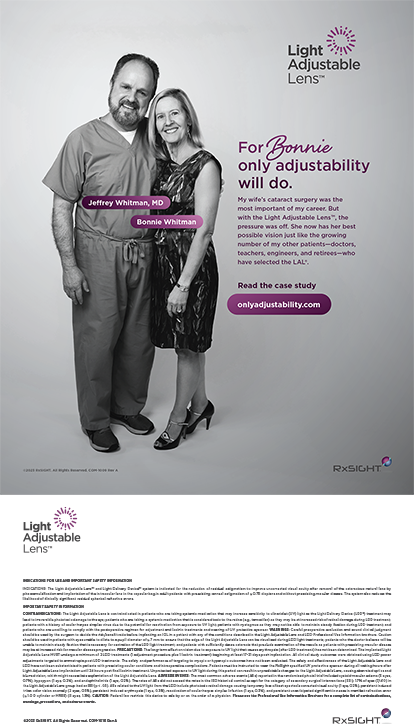The most common major complication of LASIK is corneal irregular astigmatism. Irregular astigmatism may result from various factors, such as a LASIK flap of variable depth, a very thin LASIK flap, flap undulations, or a malfunctioning excimer laser with an inconsistent ablation pattern. It has become increasingly clear that although the excitement concerning LASIK has been linked mostly to the excimer laser, that the quality of the LASIK flap determines the outcome of the LASIK surgery to a much greater extent than the specific brand of excimer laser. If the excimer laser were the dominant factor in LASIK outcomes, all surgeons with the same laser would have similar results. Because this is not true, the art of LASIK depends on the surgeon's experience, skill, and judgment in creating an excellent corneal flap.
THE ART OF LASIKTreatment
Prevention. When irregular astigmatism occurs, its treatment following LASIK can be very challenging. The treatment options, in increasing severity and risk are, 1) PRK, 2) lamellar corneal transplant and PRK/LASIK, and 3) penetrating corneal transplant and PRK/LASIK. Many refractive surgeons may be surprised to see PRK at the top of the list.
A common misconception. Some surgeons believe that when performing PRK, the surface shape of the cornea will be mimicked exactly as the corneal stroma is removed; however, this is not true. For example, the corneal folds (striae by slit lamp) of Bowman's membrane easily disappear as a myopic PRK is performed. The reason for this differential ablation pattern is probably the result of two factors—first, the top of the peaks are hit directly by the excimer beam, creating a more efficient absorption of energy and a greater ablation effect than that caused by the laser beam striking the side of the peak at an oblique angle. Secondly, moisture accumulates in the valleys, decreasing the effect of the excimer ablation. No matter what the reasons, it is a clinical fact substantiated by direct observation, that this differential ablation pattern does occur.
The Haze Factor
Historically, the greatest problem with PRK following LASIK has been the formation of corneal haze. This problem has been almost completely eliminated through use of 0.02% mitomycin C applied to the stromal bed with a surgical sponge at the conclusion of PRK for 2 minutes, and then rinsed away with BSS® (Alcon Surgical, Fort Worth, TX). It is interesting to note that corneal haze almost never forms with hyperopic PRK, but only with myopic PRK (MPRK) following a previous corneal refractive procedure. A possible explanation for this clinical observation is that in MPRK, the central beam is more perpendicular to the flattened central cornea and the thermal effects are greater. A 4-mm Hz rate, rather than the usual 6 Hz rate, can be used for MPRK following LASIK to minimize haze formation.
Measuring Corneal Irregular Astigmatism
The corneal irregular astigmatism following LASIK is caused by folds in Bowman's membrane that are easily seen after mechanical debridement of the epithelium. The Bowman's membrane of virtually all myopic LASIK patients who were -4.00 D or greater will show folds in Bowman's. When no irregular astigmatism is present postoperatively, these folds are concentric and low. When irregular astigmatism exists, these folds are higher, central, and multidirectional, with the appearance of a spider web.
Incidence. Corneal irregular astigmatism is more common following myopic LASIK, because the surface area of the flap exceeds that of the bed. In hyperopic LASIK, the incidence of corneal irregular astigmatism is much lower, because the surface area of the flap is less than that of the bed, and the donor tends to be draped over the apex of the cornea. However, in hyperopic LASIK, induced regular astigmatism is more common and more severe, because of crowding in the midperiphery of the cornea.
Degree. The degree of irregular astigmatism is proportional to the height of the Bowman's folds. The epithelium is passive in this process and is actually an ally, as it creates facets downward and smooths out the corneal surface. When the ability of the epithelium to facet is overcome by the height of the epithelium, the epithelium must follow the contour of the folds, and irregular astigmatism results. This fold height correlates best and easily to best spectacle-corrected visual acuity. A hard contact lens overcorrection should be performed to ascertain the best visual potential. PRK works best in corneas with irregular astigmatism with at least 20/40 best-spectacle corrected visual acuity.
PRK TECHNIQUE
A standard MPRK is performed, except that the 4 Hz setting (Star S3™; VISX, Santa Clara, CA) is used. Epithelium may be removed either transepithelially or by scraping. Scraping has the advantage that Bowman's is exposed evenly in all areas, but care must be taken not to dislodge a LASIK flap. After mechanical debridement of the epithelium, the surgeon can observe the “spider web” pattern of Bowman's folds that are causing the irregular astigmatism, and watch them fade away as the PRK progresses.
Corneal irregular astigmatism that causes 20/40 best-spectacle corrected visual acuity has folds that are about 10 mm to 15 mm high. A minimum treatment of -1.50 D by MPRK is required in order to significantly smooth out these folds in the visual axis. It is very important to realize that the endpoint of treatment does not mean that the folds must be completely removed; only that they be low enough for the epithelium to facet in and create a perfectly smooth anterior surface, rather than the epithelium following the peaks and valleys of Bowman's membrane as before.
A Quandary
Assume that the surgeon is faced with a cornea that has best spectacle-corrected vision of 20/40 with essentially no refractive error following LASIK. If the surgeon chooses to perform MPRK, this will create hyperopia. In such a case, an MPRK for about -2.00 D of myopia should be performed in order to reduce or eliminate the irregular astigmatism. Two months later, hyperopic PRK will be performed for the residual refractive error. It is crucial that the surgeon always correct irregular astigmatism before attempting to correct the refractive error. These two functions can sometimes be combined, but not often.
Keratoconus
In addition to using PRK to treat the corneal irregular astigmatism of LASIK complications, I have 10-year follow-up on PRK treatment of mild keratoconus. If a patient is 20/40 or better with spectacle correction, a keratoconus patient can usually benefit greatly from PRK. Uncorrected and best-corrected visual acuity improves. LASIK is absolutely contraindicated even in mild keratoconus, because the weakening of the cornea will result in even greater irregular astigmatism. The removal of minimal amounts of stoma during PRK does not seem to weaken the cornea enough to be of any clinical significance. The patient must be advised that a penetrating keratoplasty may be necessary following PRK, but in about 40 cases so far, no penetrating keratoplasty has been necessary.
SUMMARY
MPRK has been a very valuable tool in treating corneal irregular astigmatism. No masking agent is necessary. Up to this point, a broad-beam excimer laser, with epithelial faceting postoperatively, is a very effective method for repairing mild irregular astigmatism by creating a smooth corneal surface. “Custom cornea” is a promising concept, but the exact alignment between the laser and the cornea is presently problematic, and only time will tell if “custom cornea” can fulfill its promise.


